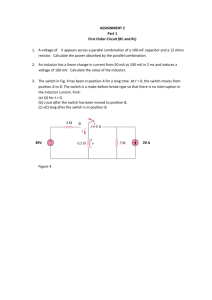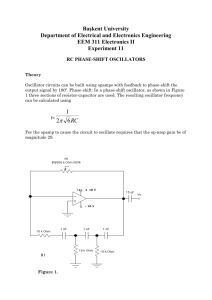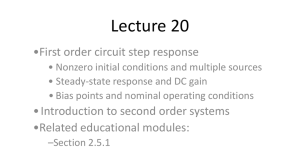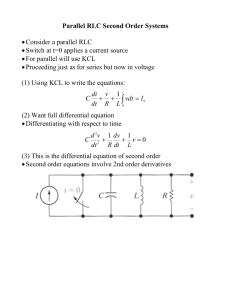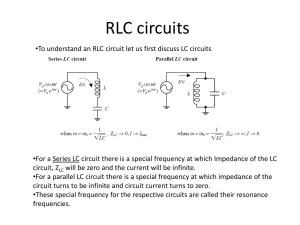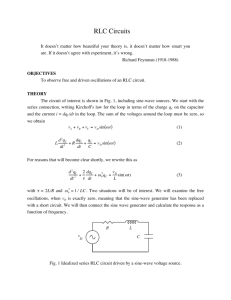RLC Measurement Using Virtual Counting Techniques
advertisement
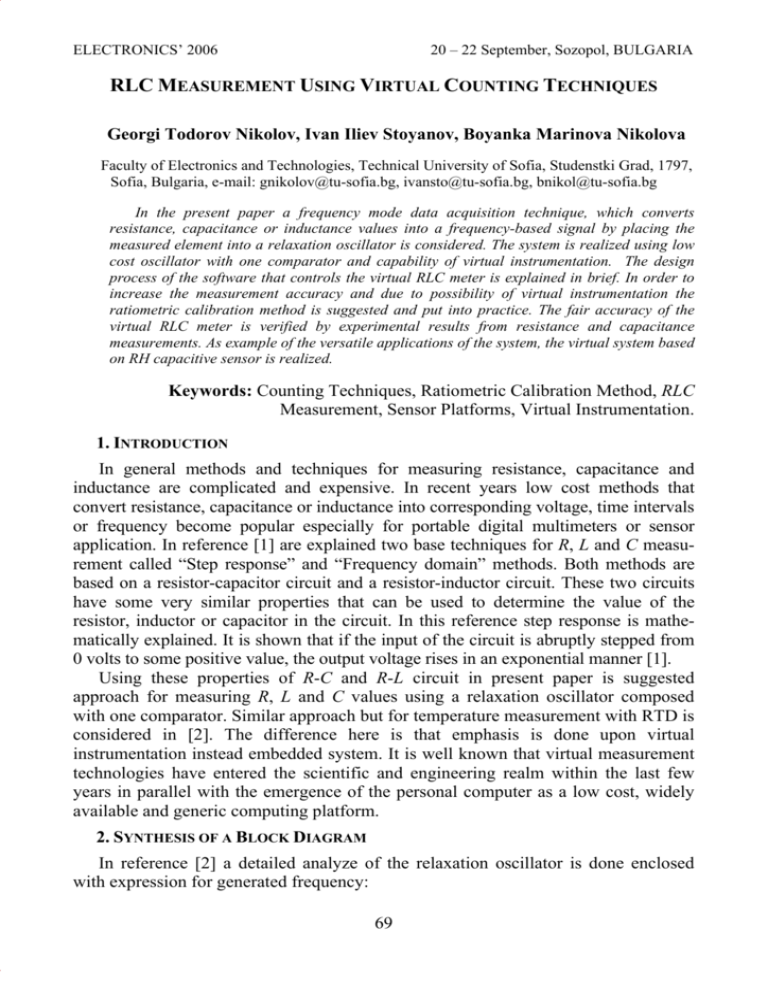
ELECTRONICS’ 2006 20 – 22 September, Sozopol, BULGARIA RLC MEASUREMENT USING VIRTUAL COUNTING TECHNIQUES Georgi Todorov Nikolov, Ivan Iliev Stoyanov, Boyanka Marinova Nikolova Faculty of Electronics and Technologies, Technical University of Sofia, Studenstki Grad, 1797, Sofia, Bulgaria, e-mail: gnikolov@tu-sofia.bg, ivansto@tu-sofia.bg, bnikol@tu-sofia.bg In the present paper a frequency mode data acquisition technique, which converts resistance, capacitance or inductance values into a frequency-based signal by placing the measured element into a relaxation oscillator is considered. The system is realized using low cost oscillator with one comparator and capability of virtual instrumentation. The design process of the software that controls the virtual RLC meter is explained in brief. In order to increase the measurement accuracy and due to possibility of virtual instrumentation the ratiometric calibration method is suggested and put into practice. The fair accuracy of the virtual RLC meter is verified by experimental results from resistance and capacitance measurements. As example of the versatile applications of the system, the virtual system based on RH capacitive sensor is realized. Keywords: Counting Techniques, Ratiometric Calibration Method, RLC Measurement, Sensor Platforms, Virtual Instrumentation. 1. INTRODUCTION In general methods and techniques for measuring resistance, capacitance and inductance are complicated and expensive. In recent years low cost methods that convert resistance, capacitance or inductance into corresponding voltage, time intervals or frequency become popular especially for portable digital multimeters or sensor application. In reference [1] are explained two base techniques for R, L and C measurement called “Step response” and “Frequency domain” methods. Both methods are based on a resistor-capacitor circuit and a resistor-inductor circuit. These two circuits have some very similar properties that can be used to determine the value of the resistor, inductor or capacitor in the circuit. In this reference step response is mathematically explained. It is shown that if the input of the circuit is abruptly stepped from 0 volts to some positive value, the output voltage rises in an exponential manner [1]. Using these properties of R-C and R-L circuit in present paper is suggested approach for measuring R, L and C values using a relaxation oscillator composed with one comparator. Similar approach but for temperature measurement with RTD is considered in [2]. The difference here is that emphasis is done upon virtual instrumentation instead embedded system. It is well known that virtual measurement technologies have entered the scientific and engineering realm within the last few years in parallel with the emergence of the personal computer as a low cost, widely available and generic computing platform. 2. SYNTHESIS OF A BLOCK DIAGRAM In reference [2] a detailed analyze of the relaxation oscillator is done enclosed with expression for generated frequency: 69 ELECTRONICS’ 2006 20 – 22 September, Sozopol, BULGARIA 1 , (1) kRC where k is circuit specific coefficient. This coefficient can be determined by minimal and maximal voltage generated by comparator, and by range of the used hysteresis. Using expressions for R-L circuit it is possible to achieve that if R is replaced by L and C by R then output frequency will be: R . (2) f OUT = kL It is easy to consider that to measure a resistor, inductor or capacitor, the unknown component is connected in an R-C or R-L circuit as appropriate. It is assumed that for C measurement the resistor is known or can be accurately measured independently and vice versa. The block diagram of designed virtual RLC meter is shown in fig. 1. This virtual instrument consists of the following blocks: the relaxation oscillator, switching block, a set of resistors and capacitors with accurate reference values, data acquisition system, personal computer and appropriate software. f OUT = VS Oscillator Supply Voltage DAQ Switching Block RX, Rcal, RCr ef , LX + R3 Comparator f OUT Counter Input − SwC R1 Personal Computer Software (LabVIEW) R2 Digital Output GND CX, Ccal, Cref , RLref Fig. 1 The block diagram of virtual RLC meter The oscillator circuit consists of a comparator with a positive feedback loop, which converts the time-varying signal into a square wave with a varying time period. This signal can be counted and digitized into a value that is proportional to the oscillator frequency, and in turn, proportional to the R, L or C measured. This type of oscillator has lower initial accuracy but is easily tunable over broad ranges. The key attribute of oscillator is that this circuit can produce an accuracy and resolution that is much better than an analog output voltage circuit. The accuracy of the oscillator’s frequency measurement is limited only by the accuracy of the frequency counter used. The switching block is dedicated to perform the commutation in order to achieve appropriate configuration in measuring modes and ranges. The designed virtual RLC meter has tree operation modes for R, L and C measurement respectively. In addition 70 ELECTRONICS’ 2006 20 – 22 September, Sozopol, BULGARIA this block ensures commutation for external calibration resistances, coils or capacitors. One of more important advantages of multifunctional data acquisition systems is that they have build-in number of flexible counters [5]. Usually the counter is used to count the number of electronic pulses, the duration of the pulse, or the rate of pulses coming out of an external device. For frequency measurement the counter records the number of pulses (counts) per unit of time (gate). Frequency is the count divided by the gate time. If the frequency is quite low or high, a reciprocal counter is used to make a period measurement [4]. In presented virtual RLC meter the frequency generated by oscillator is measured using reciprocal counter techniques. Further the graphical programming environment calculates the measured values. 3. ACHIEVING HIGH ACCURACY USING CALIBRATION Unfortunately, direct conversion of the output frequency into component value (R, C or L) using the equation (1) is supported by error due to its nonlinearity. It is possible to work out an equation describing how the magnitude of resistor R and capacitor C bring influence to the comparator output voltages and changing coefficient k. Therefore that affects frequency, especially if the changes in high and low output voltages are not symmetrical. To increase the resolution of the described virtual RLC system, a calibration approach, based on ratiometric measurement of the frequency is proposed and applied. In order to minimize error of nonlinearity a calibration component with accurate value Xcal is connected instead of the measured component. Then the oscillating frequency fcal is measured and store by the virtual system. In that case, using the equation (1), the unknown value XX of the measured component can be obtained as a ratio of two frequencies: f X X = cal X cal . (3) fX Should be appointed, that by using the suggested calibration method the parasitic capacitance, resistance and inductance will be compensated as well. 4. SOFTWARE DESIGN Because natural languages are less precise than programming languages, usually modeling languages, such as the Unified Modeling Language (UML) are used in a problem-solving process to bridge the chasm between the requirements and the system. UML may be applied throughout the system-development process all the way from requirements gathering to implementation of the system [4]. Such approach is applied here in order to create software that controls the virtual system. Using the UML, it is possible to communicate the implementation of a system using component and state chart diagrams. Ones the needed components are obtained and state charts are created, it is easy to determine the appropriate design patterns. To control virtual system for RLC measurement most appropriate is standard state machine design pattern. To build a standard state machine the template offered by 71 ELECTRONICS’ 2006 20 – 22 September, Sozopol, BULGARIA National Instruments is used. The created programming code is shown in fig. 2. Each state executes code and determines which state to transition to. Fig. 2 The block diagram in state of the frequency measurement The user interface or so-called front panel of the created virtual system is shown in fig. 3. The front panel consists of three main sections. The first one is placed in left and is related to the selection of measurement mode. The next section is placed in central part of the front panel and consists of menu rings for choose of measurement range. There are and numeric control for user defined external reference component. The last section consists of digital indicators that indicated the measured value and current frequency. Fig. 3 The front panel of virtual RLC meter Fig. 4 The dialog box for calibration The mentioned above high resolution mode can be selected by button “High Accuracy”. The dialog box that is appeared in this case is shown in fig. 4. To 72 ELECTRONICS’ 2006 20 – 22 September, Sozopol, BULGARIA accomplish measurement with high accuracy the user must fulfill the exact value of the calibration component and by pressing the button “Convert Calibration Value” he will be returned in main block diagram with displayed result. 5. EXPERIMENTAL RESULTS AND APPLICATION 5.1 Measurement of resistors and capacitors In order to define the measurement accuracy of the realized virtual system a set of arbitrary selected resistors and capacitors are measured. The obtained results are summarized into table 1 and table 2 respectively. As can be seen a sufficient accuracy is achieved especially if resistors and capacitors are not too large or too small. The exact values of calibration and measured components are defined by using RLCZ analyzer with average accuracy less than 0.1%. Further improvement concerning accuracy of the presented virtual RLC meter is possible by using a higher performance comparator and by selecting precision reference and calibration components with low temperature coefficients. Table 1. Resistor measurement results Low Accuracy RX, Ω Accuracy, % Rmeas, Ω 5.908 k 9.81 k 99.8 k 313.5 k 466.3 k 1.373M 2.032 M 10.05 M 6.23 k 10.18 k 102.5 k 325.6 k 485 k 1.378 M 2.010 M 9.44 M 5.45 3.77 2.7 3.86 4.01 0.14 1.08 6.07 6.01 k 9.645 k 98.68 k 312.8 k 467.3 k 1.387 M 2.013 M 9.61 M Table 2. Capacitor measurement results Low Accuracy CX, F Accuracy, % Cmeas, F 10.136 p 14.7 p 202 p 206.7 p 206.7 p 242.4 p 9.44 n 21.17 n 169 n 459.1 n 13.09 p 17.27 p 201.1 p 194.2 p 194.2 p 227.4 p 9.8 n 21.58 n 173.7 n 474.3 n High Accuracy Accuracy, % Rmeas, Ω 29 18 0.44 6.05 6.05 6.19 3.81 1.94 2.78 3.31 1.73 1.68 1.12 0.22 0.21 1.01 0.93 4.38 High Accuracy Accuracy, % Cmeas, F 11.14 p 13.37 p 201.6 p 206.6 207.7 p 241.5 p 9.599 n 20.79 n 168.7 n 459.9 n 9.9 9 0.2 0.05 0.48 0.37 1.68 1.79 0.18 0.17 Rcal, Ω 9.81 k 5.908 k 313.5 k 466.3 k 313.5 k 2.032 M 1.373 M 2.032 M Ccal, F 14.7 p 10.136 p 206.7 p 202 p 242.4 p 206.7 p 21.17 n 9.44 n 459.1 n 169 n 5.2 Capacitive sensor application To illustrate flexibility and versatility of presented system for resistance, capacitance and inductance measurement a virtual instrument for relative humidity 73 ELECTRONICS’ 2006 Fig. 5 RH measurement using capacitive sensor 20 – 22 September, Sozopol, BULGARIA (RH) measurement is created. As sensing element is used capacitive sensor MiniCap-2 [7]. The dielectric constant of the thin-film polymer capacitive type sensor changes linearly as a function of atmospheric relative humidity. RH is measured in the range of 0 to 100%, with a linearity and hysteresis of ±1% RH, and a typical response time less than 60 s for 90% of total range. The front panel of working virtual instrument for RH monitoring is shown in fig. 5. Should be noted that for such types of user calibrated sensor is convenient to transform directly frequency into measured phenomena, without defining resistive, capacitive or inductive values. 6. CONCLUSION In present paper a design and development of virtual RLC meter is considered. This virtual system consists of relaxation oscillator based on single comparator circuit, multifunctional DAQ, and graphical programming environment. The illustrated approach offers a simple solution for an application that needs the low cost measurement of resistors, capacitors and coils, with sufficient accuracy. In order to achieve higher accuracy calibration and compensation techniques is suggested in the presentation and practically applied. The performed experiments exemplify good precision according resistor and capacitor measurement. The realized virtual system can be used to any applications where frequency-time parameters have to be measured with highest resolution and programmable accuracy. It is perfectly suited for physical phenomena monitoring by using resistive capacitive and inductive sensors. 7. REFERENCES [1] Witte R. A. Electronic Test Instruments, Prentice Hall PTR, 2003 [2] Haile E., J. Lepkowski, Oscillator Circuits For RTD Temperature Sensors, Microchip Technology Inc., AN895, 2004. [3] Sensor Platforms Inc., SSP1492 Sensor Signal Processor Chip, Product Datasheet, V2.0 – December 13, 2005. [4] Nikolov, G., I. Stoyanov, B. Nikolova, Virtual Universal Counter, 14th International Conference Electronics '2005, Sozopol, Sept. 21-23., 2005, Conference Proceedings, v.3, pp.75-80. [5] National Instruments, DAQ-STC Technical Reference Manual, Part Number 340934A-01, May 1995. [6] Yurish S., Digital Humidity Sensors and Data Logger Design Based on Modern Frequencyto-Digital Converter, S&T e-Digest, September 2005, Vol. 59, Issue 9, pp. 419-425. [7] Panametrics, MiniCap-2 Miniatursensor zur Messung der Relativen Feuchte, Technische Daten, 2001. 74
